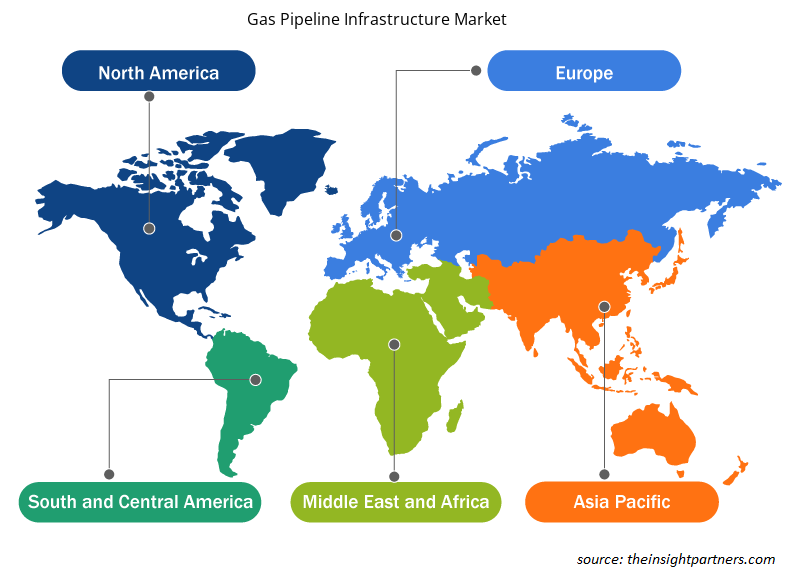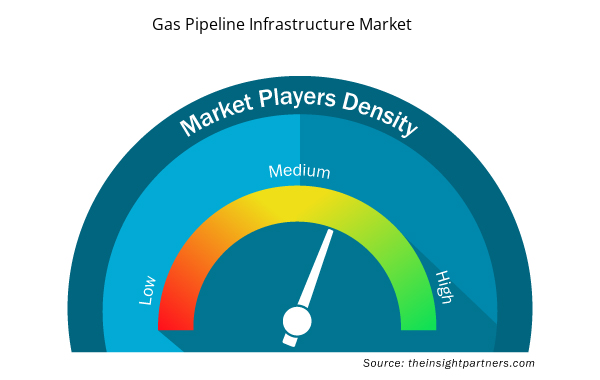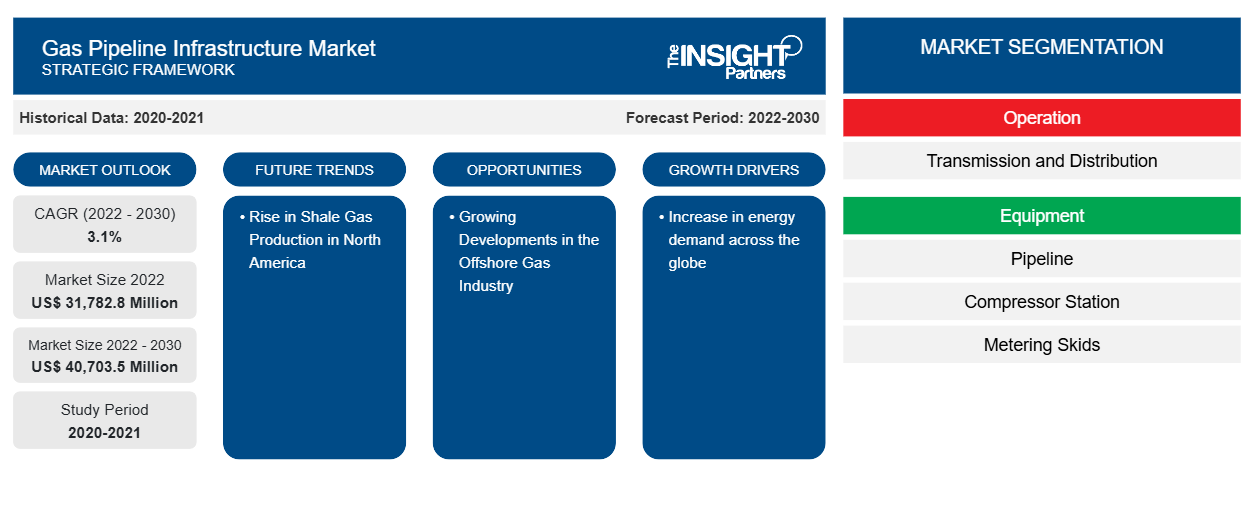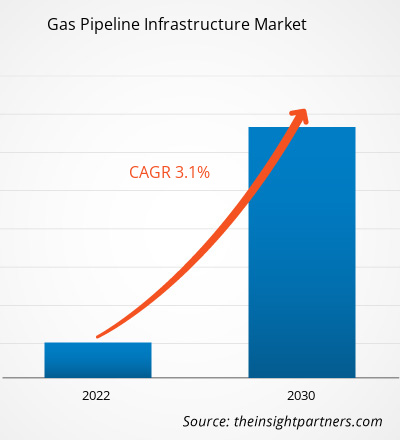من المتوقع أن يصل حجم سوق البنية التحتية لخطوط أنابيب الغاز إلى 40،703.5 مليون دولار أمريكي بحلول عام 2030 من 31،782.8 مليون دولار أمريكي في عام 2022. ومن المتوقع أن يسجل السوق معدل نمو سنوي مركب بنسبة 3.1٪ في الفترة 2022-2030.
تحليل سوق البنية التحتية لخطوط أنابيب الغاز
إن سوق الغاز الطبيعي ديناميكي للغاية ويتطلب السيولة والمرونة والشفافية للعمل بشكل فعال. وبالتالي، هناك حاجة إلى مصادر متعددة للإمداد ومستخدمين متعددين وبنية أساسية شاملة للنقل والتوزيع. وقد تطورت سوق الغاز الطبيعي بشكل كبير في الولايات المتحدة وأوروبا ومنطقة آسيا والمحيط الهادئ، ومن المتوقع أن يدفع ذلك نمو البنية الأساسية لخطوط أنابيب الغاز مع ارتفاع الطلب على الغاز في المستقبل.
نظرة عامة على سوق البنية التحتية لخطوط أنابيب الغاز
يتضمن نظام البنية التحتية لخطوط أنابيب الغاز مرحلة الإنتاج، حيث يتم استخراج الغاز الطبيعي من الخزانات الجوفية. تستخدم شركات الاستكشاف والإنتاج تقنيات الحفر لاستخراج الغاز الطبيعي الخام. بمجرد استخراجه، تتم معالجة الغاز عادةً لإزالة الشوائب ثم ضغطه للنقل. تتضمن مرحلة الإنتاج اعتبارات العوامل الجيولوجية وتقنيات الاستخراج وتقييمات الأثر البيئي. اللاعبون الأساسيون المشاركون في إنتاج الغاز الطبيعي هم Royal Dutch Shell و ExxonMobil Corporation و Gazprom و ConocoPhillips و TotalEnergie . يشمل اللاعبون الرئيسيون في شبكة نقل خطوط أنابيب الغاز Kinder Morgan Inc. و Enbridge Inc. وTC Energy Corporation و Pembina Pipeline Corporation وTexas Gas Transmission LLC وغيرها.
قم بتخصيص هذا التقرير ليناسب متطلباتك
ستحصل على تخصيص لأي تقرير - مجانًا - بما في ذلك أجزاء من هذا التقرير، أو تحليل على مستوى الدولة، وحزمة بيانات Excel، بالإضافة إلى الاستفادة من العروض والخصومات الرائعة للشركات الناشئة والجامعات
- احصل على أهم اتجاهات السوق الرئيسية لهذا التقرير.ستتضمن هذه العينة المجانية تحليلاً للبيانات، بدءًا من اتجاهات السوق وحتى التقديرات والتوقعات.
محركات وفرص سوق البنية التحتية لخطوط أنابيب الغاز
من المتوقع أن يكون ارتفاع الطلب على الطاقة في جميع أنحاء العالم هو المحرك الرئيسي لسوق البنية التحتية لخطوط أنابيب الغاز
إن الزيادة في عدد السكان والتوسع الحضري المتزايد من العوامل التي تعزز استهلاك الطاقة في جميع أنحاء العالم. يتمتع الغاز الطبيعي بإمكانات التطبيق في توليد الكهرباء، مما يعزز الطلب عليه. وعلاوة على ذلك، وبسبب عدم اليقين المتزايد بشأن الطاقة في أوروبا بسبب الحرب بين روسيا وأوكرانيا، تعمل حكومات العديد من البلدان أيضًا على تعزيز استخدام الغاز الطبيعي. وبالتالي، فإن الزيادة في الطلب على الطاقة تغذي نمو سوق البنية التحتية لخطوط أنابيب الغاز.
ارتفاع إنتاج الغاز الصخري في أميركا الشمالية
لقد نجحت أمريكا الشمالية في ترسيخ مكانتها كواحدة من أكبر منتجي الغاز الصخري في العالم. وتعد كندا خامس أكبر منتج ورابع أكبر مصدر للغاز الطبيعي في العالم. وتشمل حقول الغاز الصخري الرئيسية في كندا حوض هورن ريفر ومونتني في شمال شرق كولومبيا البريطانية، وزيت يوتيكا في كيبيك، ومجموعة كولورادو في ألبرتا وساسكاتشوان، وزيت هورتون بلاف في نيو برونزويك ونوفا سكوشا. وتعمل حالة عدم اليقين بشأن الطاقة بسبب الاضطرابات الجيوسياسية على تعزيز إنتاج الغاز الصخري في أمريكا الشمالية، وهو ما من المرجح أن يخلق فرصًا كبيرة لنمو سوق البنية التحتية لخطوط أنابيب الغاز في السنوات القادمة.
تقرير تحليل تجزئة سوق البنية التحتية لخطوط أنابيب الغاز
إن القطاعات الرئيسية التي ساهمت في اشتقاق تحليل سوق البنية التحتية لخطوط أنابيب الغاز هي التشغيل والمعدات والتطبيق.
- بناءً على التشغيل، تم تقسيم سوق البنية التحتية لخطوط أنابيب الغاز إلى النقل والتوزيع. احتل قطاع التوزيع حصة سوقية أكبر في عام 2022.
- من حيث المعدات، تم تقسيم السوق إلى خطوط الأنابيب ومحطات الضاغط ومنصات القياس وغيرها. وقد هيمن قطاع خطوط الأنابيب على السوق في عام 2022.
- من حيث التطبيق، تم تقسيم السوق إلى برية وبحرية. سيطر القطاع البري على السوق في عام 2022.
تحليل حصة سوق البنية التحتية لخطوط أنابيب الغاز حسب المنطقة الجغرافية
ينقسم النطاق الجغرافي لتقرير سوق البنية التحتية لخطوط أنابيب الغاز بشكل أساسي إلى خمس مناطق: أمريكا الشمالية وأوروبا وآسيا والمحيط الهادئ والشرق الأوسط وأفريقيا وأمريكا الجنوبية.
أمريكا الشمالية هي واحدة من أكبر الدول المصدرة للغاز. إن الطلب المتزايد على الطاقة والتطبيق المتزايد للغاز الطبيعي يعززان تطوير سوق البنية التحتية لخطوط أنابيب الغاز في أمريكا الشمالية. في عام 2022، أظهرت الولايات المتحدة أعلى قدرة على إنتاج الغاز الطبيعي، تليها كندا والمكسيك. تعد حقول Ixachi وCoulomb Phase 2 وQuesqui وNejo (IEPC) وLeo وMay وKoban وPowerball من بين حقول إنتاج الغاز الطبيعي في أمريكا الشمالية. يقع مصنع Ixachi في فيراكروز بالمكسيك، وقد أنتج 618.09 مليون قدم مكعب يوميًا في عام 2022. كما من المتوقع أن يعزز العدد المتزايد من المبادرات الحكومية والتمويل لتطوير البنية التحتية لخطوط أنابيب الغاز سوق البنية التحتية لخطوط أنابيب الغاز خلال الفترة المتوقعة.
رؤى إقليمية حول سوق البنية التحتية لخطوط أنابيب الغاز
لقد قام المحللون في Insight Partners بشرح الاتجاهات والعوامل الإقليمية المؤثرة على سوق البنية التحتية لخطوط أنابيب الغاز طوال فترة التوقعات بشكل شامل. يناقش هذا القسم أيضًا قطاعات سوق البنية التحتية لخطوط أنابيب الغاز والجغرافيا في جميع أنحاء أمريكا الشمالية وأوروبا ومنطقة آسيا والمحيط الهادئ والشرق الأوسط وأفريقيا وأمريكا الجنوبية والوسطى.

- احصل على البيانات الإقليمية المحددة لسوق البنية التحتية لخطوط أنابيب الغاز
نطاق تقرير سوق البنية التحتية لخطوط أنابيب الغاز
| سمة التقرير | تفاصيل |
|---|---|
| حجم السوق في عام 2022 | 31,782.8 مليون دولار أمريكي |
| حجم السوق بحلول عام 2030 | 40,703.5 مليون دولار أمريكي |
| معدل النمو السنوي المركب العالمي (2022 - 2030) | 3.1% |
| البيانات التاريخية | 2020-2021 |
| فترة التنبؤ | 2022-2030 |
| القطاعات المغطاة | حسب العملية
|
| المناطق والدول المغطاة | أمريكا الشمالية
|
| قادة السوق وملفات تعريف الشركات الرئيسية |
|
كثافة اللاعبين في سوق البنية التحتية لخطوط أنابيب الغاز: فهم تأثيرها على ديناميكيات الأعمال
يشهد سوق البنية التحتية لخطوط أنابيب الغاز نموًا سريعًا، مدفوعًا بالطلب المتزايد من المستخدم النهائي بسبب عوامل مثل تفضيلات المستهلكين المتطورة والتقدم التكنولوجي والوعي المتزايد بفوائد المنتج. ومع ارتفاع الطلب، تعمل الشركات على توسيع عروضها والابتكار لتلبية احتياجات المستهلكين والاستفادة من الاتجاهات الناشئة، مما يؤدي إلى زيادة نمو السوق.
تشير كثافة اللاعبين في السوق إلى توزيع الشركات أو المؤسسات العاملة في سوق أو صناعة معينة. وهي تشير إلى عدد المنافسين (اللاعبين في السوق) الموجودين في مساحة سوق معينة نسبة إلى حجمها أو قيمتها السوقية الإجمالية.
الشركات الرئيسية العاملة في سوق البنية التحتية لخطوط أنابيب الغاز هي:
- شركة إنبريدج
- شركة كيندر مورجان
- شركة تي سي للطاقة
- شركة بيمبينا لخطوط الأنابيب
- مجموعة سينوبيك
- البنية التحتية لخطوط الأنابيب المحدودة
إخلاء المسؤولية : الشركات المذكورة أعلاه ليست مرتبة بأي ترتيب معين.

- احصل على نظرة عامة على أهم اللاعبين الرئيسيين في سوق البنية التحتية لخطوط أنابيب الغاز
أخبار سوق البنية التحتية لخطوط أنابيب الغاز والتطورات الأخيرة
يتم تقييم سوق البنية التحتية لخطوط أنابيب الغاز من خلال جمع البيانات النوعية والكمية بعد البحث الأولي والثانوي، والذي يتضمن منشورات الشركات المهمة وبيانات الجمعيات وقواعد البيانات. فيما يلي قائمة بالتطورات في سوق البنية التحتية لخطوط أنابيب الغاز والاستراتيجيات:
- في فبراير 2023، وقعت شركة Enagas SA اتفاقية مع شركة Reganosa دفعت بموجبها شركة Enagas مبلغ 58.14 مليون دولار أمريكي لشركة Reganosa لشراء شبكة من خطوط أنابيب الغاز الطبيعي بطول 130 كيلومترًا. ويعتمد التشغيل الفعال لسوق الغاز الأيبيرية وأمن الإمدادات على هذه الشبكة. (المصدر: شركة Enagas SA، بيان صحفي/موقع الشركة على الويب/النشرة الإخبارية)
- في أغسطس 2022، تم الاتفاق على اتفاقية استراتيجية بين شركة TC Energy Corp وشركة CFE، وهي شركة المرافق الكهربائية المملوكة للدولة في المكسيك، بهدف تسريع تطوير البنية التحتية للغاز الطبيعي في الأجزاء الوسطى والجنوبية الشرقية من البلاد. وفيما يتعلق بأصول خط أنابيب الغاز الطبيعي في وسط المكسيك، قررت شركة TC Energy وشركة CFE دمج اتفاقيات الاستلام أو الدفع السابقة التي تعهدت بها شركة TGNH التابعة لشركة TC Energy ومقرها المكسيك وشركة CFE في اتفاقية استلام أو دفع واحدة بسعر الدولار الأمريكي والتي ستستمر حتى عام 2055. كما ستخضع مشاريع البنية التحتية الجديدة ذات الصلة التي يتم التخطيط لها بالتعاون مع شركة CFE لاتفاقية الاستلام أو الدفع الجديدة هذه. (المصدر: شركة TC Energy، بيان صحفي/موقع الشركة على الويب/النشرة الإخبارية)
تقرير سوق البنية التحتية لخطوط أنابيب الغاز - التغطية والنتائج المتوقعة
يوفر تقرير "حجم سوق البنية التحتية لخطوط أنابيب الغاز والتوقعات (2020-2030)" تحليلاً مفصلاً للسوق يغطي المجالات التالية:
- حجم السوق والتوقعات على المستويات العالمية والإقليمية والوطنية لجميع قطاعات السوق الرئيسية التي يغطيها النطاق
- ديناميكيات السوق مثل المحركات والقيود والفرص الرئيسية
- الاتجاهات المستقبلية الرئيسية
- تحليل مفصل لـ PEST
- تحليل السوق العالمي والإقليمي الذي يغطي اتجاهات السوق الرئيسية واللاعبين الرئيسيين واللوائح والتطورات الأخيرة في السوق
- تحليل المشهد الصناعي والمنافسة الذي يغطي تركيز السوق، وتحليل خريطة الحرارة، واللاعبين البارزين، والتطورات الأخيرة
- ملفات تعريف تفصيلية للشركة مع تحليل SWOT
- التحليل التاريخي (سنتان)، السنة الأساسية، التوقعات (7 سنوات) مع معدل النمو السنوي المركب
- تحليل PEST و SWOT
- حجم السوق والقيمة / الحجم - عالميًا وإقليميًا وقطريًا
- الصناعة والمنافسة
- مجموعة بيانات Excel


- Trade Promotion Management Software Market
- Foot Orthotic Insoles Market
- Grant Management Software Market
- Genetic Testing Services Market
- Dry Eye Products Market
- Cling Films Market
- Nurse Call Systems Market
- Parking Management Market
- Lymphedema Treatment Market
- Biopharmaceutical Contract Manufacturing Market

Report Coverage
Revenue forecast, Company Analysis, Industry landscape, Growth factors, and Trends

Segment Covered
This text is related
to segments covered.

Regional Scope
North America, Europe, Asia Pacific, Middle East & Africa, South & Central America

Country Scope
This text is related
to country scope.
Trends and growth analysis reports related to Energy and Power : READ MORE..
The Insight Partners performs research in 4 major stages: Data Collection & Secondary Research, Primary Research, Data Analysis and Data Triangulation & Final Review.
- Data Collection and Secondary Research:
As a market research and consulting firm operating from a decade, we have published and advised several client across the globe. First step for any study will start with an assessment of currently available data and insights from existing reports. Further, historical and current market information is collected from Investor Presentations, Annual Reports, SEC Filings, etc., and other information related to company’s performance and market positioning are gathered from Paid Databases (Factiva, Hoovers, and Reuters) and various other publications available in public domain.
Several associations trade associates, technical forums, institutes, societies and organization are accessed to gain technical as well as market related insights through their publications such as research papers, blogs and press releases related to the studies are referred to get cues about the market. Further, white papers, journals, magazines, and other news articles published in last 3 years are scrutinized and analyzed to understand the current market trends.
- Primary Research:
The primarily interview analysis comprise of data obtained from industry participants interview and answers to survey questions gathered by in-house primary team.
For primary research, interviews are conducted with industry experts/CEOs/Marketing Managers/VPs/Subject Matter Experts from both demand and supply side to get a 360-degree view of the market. The primary team conducts several interviews based on the complexity of the markets to understand the various market trends and dynamics which makes research more credible and precise.
A typical research interview fulfils the following functions:
- Provides first-hand information on the market size, market trends, growth trends, competitive landscape, and outlook
- Validates and strengthens in-house secondary research findings
- Develops the analysis team’s expertise and market understanding
Primary research involves email interactions and telephone interviews for each market, category, segment, and sub-segment across geographies. The participants who typically take part in such a process include, but are not limited to:
- Industry participants: VPs, business development managers, market intelligence managers and national sales managers
- Outside experts: Valuation experts, research analysts and key opinion leaders specializing in the electronics and semiconductor industry.
Below is the breakup of our primary respondents by company, designation, and region:

Once we receive the confirmation from primary research sources or primary respondents, we finalize the base year market estimation and forecast the data as per the macroeconomic and microeconomic factors assessed during data collection.
- Data Analysis:
Once data is validated through both secondary as well as primary respondents, we finalize the market estimations by hypothesis formulation and factor analysis at regional and country level.
- Macro-Economic Factor Analysis:
We analyse macroeconomic indicators such the gross domestic product (GDP), increase in the demand for goods and services across industries, technological advancement, regional economic growth, governmental policies, the influence of COVID-19, PEST analysis, and other aspects. This analysis aids in setting benchmarks for various nations/regions and approximating market splits. Additionally, the general trend of the aforementioned components aid in determining the market's development possibilities.
- Country Level Data:
Various factors that are especially aligned to the country are taken into account to determine the market size for a certain area and country, including the presence of vendors, such as headquarters and offices, the country's GDP, demand patterns, and industry growth. To comprehend the market dynamics for the nation, a number of growth variables, inhibitors, application areas, and current market trends are researched. The aforementioned elements aid in determining the country's overall market's growth potential.
- Company Profile:
The “Table of Contents” is formulated by listing and analyzing more than 25 - 30 companies operating in the market ecosystem across geographies. However, we profile only 10 companies as a standard practice in our syndicate reports. These 10 companies comprise leading, emerging, and regional players. Nonetheless, our analysis is not restricted to the 10 listed companies, we also analyze other companies present in the market to develop a holistic view and understand the prevailing trends. The “Company Profiles” section in the report covers key facts, business description, products & services, financial information, SWOT analysis, and key developments. The financial information presented is extracted from the annual reports and official documents of the publicly listed companies. Upon collecting the information for the sections of respective companies, we verify them via various primary sources and then compile the data in respective company profiles. The company level information helps us in deriving the base number as well as in forecasting the market size.
- Developing Base Number:
Aggregation of sales statistics (2020-2022) and macro-economic factor, and other secondary and primary research insights are utilized to arrive at base number and related market shares for 2022. The data gaps are identified in this step and relevant market data is analyzed, collected from paid primary interviews or databases. On finalizing the base year market size, forecasts are developed on the basis of macro-economic, industry and market growth factors and company level analysis.
- Data Triangulation and Final Review:
The market findings and base year market size calculations are validated from supply as well as demand side. Demand side validations are based on macro-economic factor analysis and benchmarks for respective regions and countries. In case of supply side validations, revenues of major companies are estimated (in case not available) based on industry benchmark, approximate number of employees, product portfolio, and primary interviews revenues are gathered. Further revenue from target product/service segment is assessed to avoid overshooting of market statistics. In case of heavy deviations between supply and demand side values, all thes steps are repeated to achieve synchronization.
We follow an iterative model, wherein we share our research findings with Subject Matter Experts (SME’s) and Key Opinion Leaders (KOLs) until consensus view of the market is not formulated – this model negates any drastic deviation in the opinions of experts. Only validated and universally acceptable research findings are quoted in our reports.
We have important check points that we use to validate our research findings – which we call – data triangulation, where we validate the information, we generate from secondary sources with primary interviews and then we re-validate with our internal data bases and Subject matter experts. This comprehensive model enables us to deliver high quality, reliable data in shortest possible time.


 احصل على عينة مجانية لهذا التقرير
احصل على عينة مجانية لهذا التقرير